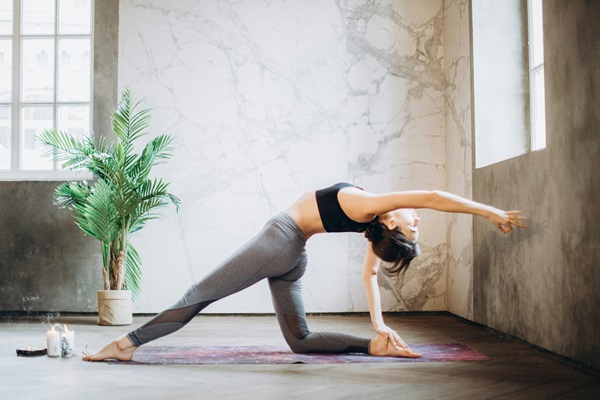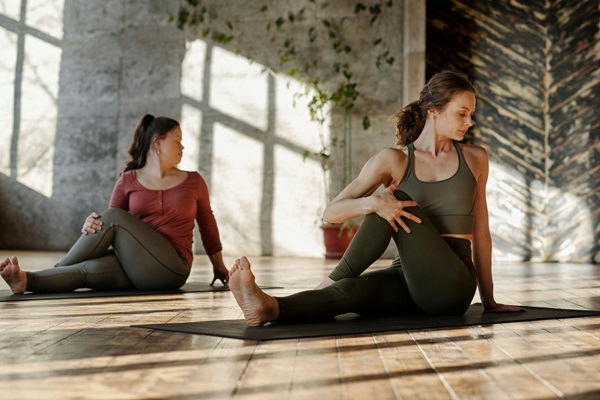I. Introduction
The Fusion of Yoga and Physical Fitness
The ancient practice of yoga, renowned for its spiritual and mental benefits, has been increasingly embraced as a potent tool for enhancing physical fitness. This fusion of ancient wisdom and modern exercise science offers a holistic approach to strength, flexibility, balance, and endurance, making yoga for physical fitness a cornerstone in contemporary wellness routines.

The Importance of Strength in Yoga
Strength is the cornerstone of any physical fitness regimen. In yoga, it’s not about bulging biceps but cultivating functional strength that supports your asanas (postures) and daily life. This guide will unravel the profound connection between yoga and physical strength.
II. The Foundation: Breath Control
Pranayama Techniques for Strength
Pranayama, the practice of breath control, is the foundation of yoga. By mastering your breath, you oxygenate your muscles, increase stamina, and enhance your strength. Techniques like Kapalabhati and Bhastrika provide a powerful boost to your practice.
How Breath Enhances Physical Performance
Understanding the vital link between breath and strength is key. Proper breathing techniques reduce fatigue, improve focus, and sustain your energy throughout challenging poses.
III. Yoga Postures for Building Strength
Hatha Yoga Postures
Hatha yoga is the bedrock of physical strength in yoga. It emphasizes static poses, helping you develop muscular endurance and stability. Poses like the Plank, Warrior I, and the Tree pose promote body strength.
Explanation and Benefits
Hatha poses, held with precision, engage every muscle group. They build lean muscle, improve posture, and enhance body awareness.
Sample Routine
Try this Hatha sequence: Mountain Pose, Downward Dog, Upward Dog, Warrior II, and Triangle Pose. Hold each pose for 5 breaths to develop strength and flexibility.
Vinyasa Yoga Sequences
Vinyasa yoga combines breath with movement. It fosters strength and flexibility by transitioning smoothly between poses. Sun Salutations and Warrior flows exemplify this style.
Exploring Flow and Power
Vinyasa’s dynamic nature enhances cardiovascular fitness, builds lean muscle, and strengthens the core. It’s a powerful choice for those seeking a more vigorous practice.
Key Poses and Flow Patterns
Include challenging poses like Crow, Headstand, and Side Plank in your Vinyasa sequence to promote strength and balance.
Power Yoga
Power yoga is an intense, athletic form of yoga. It’s characterized by fast-paced, challenging poses that promote muscular strength and endurance. Poses like Chaturanga Dandasana and Firefly pose push your physical limits.
The Dynamic Approach
Power yoga takes you through a rigorous workout, fostering muscle definition and cardiovascular health.
Incorporating Strength Poses
Integrate poses like the Crane, Wheel, and Peacock into your power yoga routine for a full-body strength challenge.
IV. Building Core Strength
The Role of the Core in Yoga
A strong core is the secret to mastering yoga. It stabilizes your entire practice, preventing injury and enhancing your ability to hold advanced postures.
Specific Core Strengthening Poses
Include Boat Pose, Plank Variations, and Navasana in your practice to engage your core effectively.
Core-Centric Yoga Styles
Styles like Ashtanga and Core Power Yoga focus on core strength. These practices are designed to sculpt your abs and improve overall body stability.
V. Balancing Acts: Yoga for Stability
Importance of Balance in Strength
Balance is a key component of physical strength. Balancing poses develop proprioception, muscle control, and mental focus.
Asanas for Balance and Stability
Warrior III, Tree Pose, and Half Moon Pose challenge your stability while promoting strength in the legs, core, and supporting muscles.
VI. Flexibility vs. Strength
Finding the Right Balance
While strength is vital, flexibility complements it. Balance your practice with asanas that emphasize flexibility, such as the Cobra, Upward-Facing Dog, and Bridge Pose.
Yoga for Flexibility and Strength Combined
Poses like the Pigeon Pose and King Pigeon Pose merge strength and flexibility, enhancing your range of motion and overall physical performance.
VII. Props and Aids
The Use of Props for Strength Building
Props like straps, blocks, and bolsters can be used to modify poses, making them more accessible or challenging. Props help you attain proper alignment, supporting strength development.

VIII. Mind and Muscle: Mental Practices for Physical Strength
Visualization Techniques
Mental focus is as crucial as physical strength. Visualization techniques can enhance your muscle engagement and refine your form.
Mindfulness in Strength Building
Practicing mindfulness during your yoga sessions helps you tune into your body, allowing for more deliberate and effective strength development.
IX. Precautions and Injury Prevention
Recognizing Your Limits
Yoga encourages you to challenge yourself, but it’s equally important to know when to back off. Listen to your body to prevent overexertion and injury.
The Role of Proper Alignment
Proper alignment in yoga poses is a safety net. Misalignment can lead to injury, while correct alignment fosters strength and stability.
X. Recovery and Regeneration
Importance of Rest Days
Incorporate rest days into your routine. They’re essential for muscle recovery and overall well-being.
Post-Yoga Recovery Techniques
Practices like Savasana (Corpse Pose) and Yin Yoga can be instrumental in post-workout recovery, aiding muscle repair and relaxation.
XI. Nutrition for Strength
Dietary Considerations for Yogis
Fuel your body with nutrient-dense foods. A balanced diet supports muscle growth and overall strength.
Pre- and Post-Yoga Nutrition
Timing your meals around your practice can optimize your energy levels and recovery.
XII. Hydration and Yoga for Physical Fitness
Staying Hydrated for Optimal Performance
Proper hydration is crucial for muscle function and overall physical performance. Maintain water balance during your yoga sessions.
The Connection Between Yoga and Hydration
Certain yoga styles, like Bikram, emphasize heat and sweat, making hydration even more critical for muscle function and endurance.
XIII. Progress Tracking
Setting and Measuring Strength Goals
Establish clear goals for your yoga practice. Whether it’s mastering a challenging pose or achieving a specific strength milestone, tracking your progress is motivating.
The Power of Consistency
Consistency in your practice is the key to long-term strength development. Small, regular efforts yield significant results over time.
XIV. Avoiding Overexertion
Signs of Overtraining
Recognize the signs of overtraining, such as fatigue, injury, and burnout. Balance intensity and recovery for optimal results.
Listening to Your Body
Your body communicates its limits. Pay attention to these signals, and adapt your practice accordingly.
XV. Yoga for Athletes
Yoga’s Role in Athletic Training
Athletes can benefit significantly from yoga. It complements traditional training by enhancing flexibility, balance, and mental resilience.
Yoga for Cross-Training
Yoga can serve as an effective cross-training method for athletes, reducing the risk of injury and improving overall performance.

XVI. Special Considerations
Yoga for Different Age Groups
Yoga is for everyone. Tailor your practice to your age group, considering the unique strengths and challenges each stage of life presents.
Yoga for Individuals with Health Conditions
Adaptive yoga practices cater to individuals with health conditions, promoting strength within their physical limits.
XVII. Yoga and Weight Training
Combining Yoga with Weightlifting
Integrating yoga into a weightlifting routine enhances flexibility and prevents muscle imbalances, creating a well-rounded strength regimen.
Benefits of a Holistic Approach
The synergy of yoga and weight training results in a balanced, strong, and resilient body.
XVIII. Yoga as a Lifestyle
Incorporating Yoga into Daily Life
Yoga extends beyond the mat. Infuse yoga philosophy and mindfulness into your daily routines for a more holistic approach to strength.
Beyond Asana: The Yamas and Niyamas
The Yamas (ethical guidelines) and Niyamas (self-disciplines) provide a framework for living a yogic life, nurturing strength in character.
XIX. Finding Your Strength Yoga Style
The Diversity of Yoga Styles
Explore the multitude of yoga styles to find the one that resonates with your fitness and strength goals.
Personalizing Your Practice
Customize your practice based on your unique preferences and requirements. Your yoga journey is highly personal.
XX. Tips for Practicing at Home
Creating a Home Yoga Sanctuary
Design a tranquil space at home for your yoga practice. This dedicated environment enhances your commitment and focus.
Online Resources and Classes
Access a wealth of online resources, from instructional videos to virtual classes, to support your home yoga practice.
XXI. Yoga Retreats and Workshops
Deepening Your Practice
Immerse yourself in yoga retreats and workshops. These experiences provide intensive training and rejuvenation.
Immersive Learning and Practice
Connect with expert instructors and like-minded individuals to enrich your understanding and practice of yoga for strength.
XXII. Community and Support
Joining Yoga Groups and Communities
Community support adds a social dimension to your practice, offering motivation and a sense of belonging.
The Power of Yoga Partners
Partner yoga can deepen your practice by challenging strength, balance, and trust.
XXIII. Achieving Mind-Body Harmony
The Holistic Approach to Strength
Yoga, as a holistic discipline, unites physical strength with mental clarity, emotional balance, and spiritual insight.
Strengthening the Mind-Body Connection
Meditation and mindfulness practices enhance the connection between mind and body, amplifying the benefits of your physical strength.
XXIV. Embracing the Journey
Celebrating Small Achievements
Acknowledge and celebrate the incremental improvements in your practice. Each small step contributes to significant gains in strength.
Long-term Benefits of a Strength Yoga Practice
Strength cultivated through yoga isn’t transient; it’s a lifelong investment in your well-being.
XXV. Conclusion
Summing Up the Guide
In the fusion of yoga and physical fitness, this guide has unveiled a comprehensive approach to building strength through yoga. Strength, when cultivated mindfully and consistently, becomes a transformative force that enhances both body and spirit.


